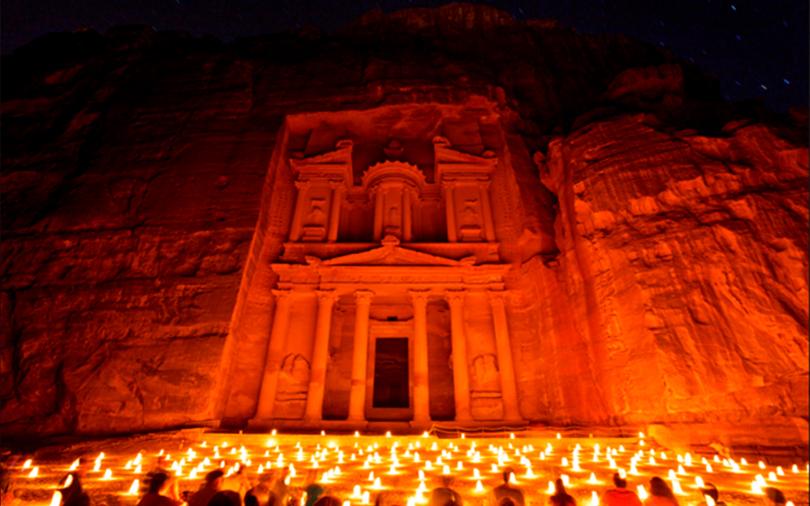Petra one of the new Seven Wonders of the World is a historical and archaeological city in the Southern Jordanian governorate of Ma'an that is famous for its rock-cut architecture and water conduit system. Another name for Petra is the Rose City due to the color of the stone out of which it is carved.
Established possibly as early as 312 BCE as the capital city of the Nabataeans, it is a symbol of Jordan, as well as Jordan's most-visited tourist attraction. It lies on the slope of Jebel al-Madhbah (identified by some as the biblical Mount Hor) in a basin among the mountains which form the eastern flank of Arabah (Wadi Araba), the large valley running from the Dead Sea to the Gulf of Aqaba. Petra has been a UNESCO World Heritage Site since 1985.
The site remained unknown to the Western world until 1812, when it was introduced by Swiss explorer Johann Ludwig Burckhardt. It was described as "a rose-red city half as old as time" in a Newdigate Prize-winning poem by John William Burgon. UNESCO has described it as "one of the most precious cultural properties of man's cultural heritage". Also, Petra was chosen by the Smithsonian Magazine as one of the "28 Places to See Before You Die".
Access the hidden archaeological treasures of the Rose City on a walk through a narrow, deep siq, where the rocks finally give way to reveal the Treasury of Petra. Petra is an erosion–hewn masterpiece. Sandstone shot with minerals burst into multi-hued colours giving off blue, red, orange and green tones. The intrepid can ascend the hundreds of rock-cut steps to Ad-Deir. Better known as the Monastery, Ad-Deir has a similar facade to that of the Treasury, but is far bigger and the views from the nearby cliff-tops are awesome.
The entire area around the site of Petra offers dramatic and varied landscapes. The canyons and high places are a maze of wind-sculptured rocks, tiny meandering tracks and secluded valleys, where the only sound is the tinkling of goat bells or the reedy notes of a shepherd’s flute. It is, in effect, an adventurer’s playground. This is a great place for walking, trekking, horseback riding and off-road cycling.
Although some activities are not permitted within the site itself, there are plenty of really great locations in the area. If you’ve explored all there is to see in Petra itself and you still have energy for more, head down the wadi to Little Petra. It may not be as quite as monumental as the main site but it was an important suburb of Petra and there is still much to see here.
To visit Petra during daylight is awe-inspiring; to experience it at night by the light of 1,800 candles is truly out-of-this-world! Walk through the Siq to the Khazneh following a candle-lit path and enjoy the haunting music of the Bedouins at the Treasury. Tours start at 8.30pm and finish at 10.00pm every Monday, Wednesday and Thursday. Tickets can be purchased from the Petra Site Office at the entrance to the site. Allow yourself plenty of time to walk through the Siq - you don't want to miss the lights!
You can also visit the website international.visitjordan.com to have more details.






